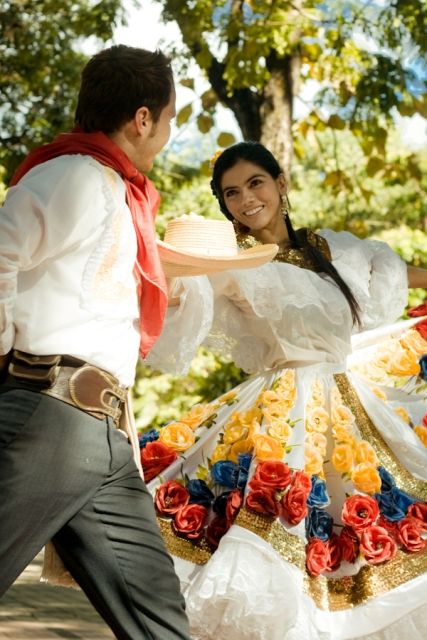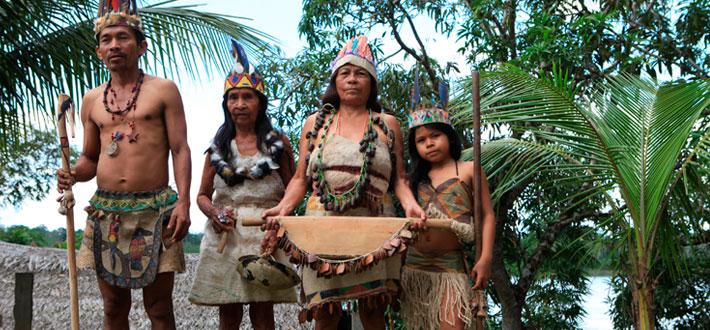Región Pacífica
To honor tradition, locals celebrate to the rhythm of the
parties in which dance and personal presentation come together to fill the
streets with color, rhythm and lots of joy. During festivals such as those of
San Pacho, held in Quibdó, the costumes are made with brightly colored silks,
including yellow, blue and red, the famous tricolor of the Colombian flag. Here
it is also celebrated with dances and songs such as currulao, patacoré, berejú
and others that require special clothing.
This type of materials and designs highlight the female
figure through simple silhouettes and decorations that give them a fun and
happy touch. Colors vary according to the celebration, but in general, during
different parties, bright and vivid colors, ruffles and embroidery stand out.
These costumes dance traditional musical genres such as
currulao, a style created from drums, drums, and clarinets or bunde. In it,
women wear a colored skirt, a scarf, and a fringed shirt, while the man wears
white. Pre-Columbian funeral traditions said that the dead were dressed in the
most "pompous" garments, which was an inspiration to the living, who
now wear their best garments.
This region is made up of the entire department of Chocó and
the coastal areas of the departments of Valle del Cauca, Cauca and Nariño. It
is characterized by its climate, which although it is varied, the warm is the
one that predominates. In addition, it is the region where the largest number
of Afro-Colombian population lives and several Indo-American tribes, which keep
alive the traditions of their ancestors.
Región Caribe
Many of those
who travel to cities like Cartagena remember Afro-Colombian women who stand out
for their colorful traditional Colombian dresses, the Palenqueras. Their costumes are full of textures,
fabrics and colors, and are complemented by the fabrics that cover their heads,
in which they load basins with tropical fruits, typical sweets such as cocadas
and corn muffins.
Day by day they go out in their costumes to delight locals
and visitors with their charm, affection and the desire to publicize their
culture. This, being another region rooted in its Afro-Colombian roots, has
made every effort to keep parties and celebrations alive, giving way to the
joy, color and flavor of its people.
Did you know that in addition to wearing their costumes to
honor roots, they are worn at big parties? Celebrations such as the Patronal
Festival of San Basilio de Palenque, the Festival of Drums and Cultural
Expressions of Palenque and the Fiestas de San Juan are perfect for dancing the
Bullerengue, a typical dance in which the woman wears colorful dresses and the
man dresses in white to generate a contrast.
Región Orinoquía
This region, located in the area of the Eastern Plains of
Colombia in the vicinity of the Orinoco River, is known for the beauty of its
landscapes, plains and savannahs and for the warmth of its people who in
everyday wear showy outfits that identify them as Nacional level.
Being an area with a diversity of climates, the locals
adapted their clothing with different materials and designs that merged with
the environment. Those who live on the coast choose light, thin, colorful
fabrics and hats to cover themselves from the sun. These allow them to move
easily during dances like the joropo and stay cool during the parties.
The characteristic step of this dance simulates the galloping
of the rider in the plains, also represents the heartbeat and the expression of
the values of culture. On the other hand, those who live in the mountains use
suits more suitable for the cold; Ponchos, wide-brimmed hats and pieces full of
details such as flowers are used with great honor.
Región Andina
This encompasses the departments of Antioquia, Caldas,
Risaralda, Quindío (Eje Cafetero), Nariño, Huila, Tolima, Cundinamarca,
Boyacá, Santander and Norte de Santander, where songs and dances like the
sanjuanero that are danced at events such as the Folkloric Festival and the
National Reign of Bambuco, the corridor and others are part of the day to day.
To celebrate popular festivals such as those of San Juan and San Pedro, locals
wear their best costumes.
To dance the sanjuanero, women wear dresses decorated with
embroidery, flowers, flat shoes that do not attract attention and a crown of
natural flowers that highlights feminine beauty. Men also wear
white; a shirt, slim pants, a red scarf and a hatpintao.
Here there is also a mestizo culture that roots Spanish and
indigenous traditions, that is why most of their dances, songs and rhythms
refer to these territories. That is why instruments such as the guitar and the
tiple are used and through the dances reference is made to the folklore based
on stories, myths and legends of the area.
Región
Amazonía
This is the
Amazon, Vichada, Vaupés, Caquetá, Putumayo, Guaviare and Guainía, areas
inhabited mostly by indigenous groups who speak their own languages; among these
the best known is the Tupí language. Due to the geographical location and culture of its people,
there is no established typical costume; However, their way of dressing in
their day to day has given them a unique identity.
Being in tropical climates, the indigenous people of the area
wear few clothes. Formerly, they walked half-naked with wooden feathered
earmuffs, small pieces of thin cloth and many accessories created with
feathers, seeds and teeth of animals. Today, the locals preserve this tradition
and create special costumes for certain celebrations.
For their rituals they use Yanchama costumes created with tree bark, decorated with vegetable dyes. These are sleeveless and have palm fringes and local leaves that represent nature. Sometimes they use wooden masks and more accessories. What is most striking about these creations are the local materials such as leaves, wood and fabrics dyed with brightly colored fruits.





No hay comentarios.:
Publicar un comentario